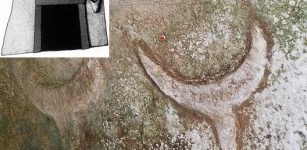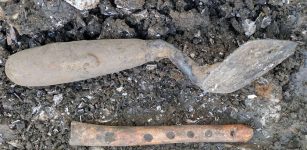Remarkable Neanderthal Flute Found In Divje Babe Cave Is The World’s Oldest Musical Instrument
Jan Bartek - AncientPages.com - Our long-gone ancestors, the Neanderthals, did not differ that much from modern humans. Like us, the Neanderthals were curious about the world around them and explored new areas. They enjoyed and collected beautiful objects. They deliberately collected perforated shells to string them together like beads 120,000 years ago. Sometimes, they used shells as body ornaments, and there is evidence Neanderthals were the world’s first artists.
One cannot and should not undermine Neandethal's intelligence and skills. They were by no means primitive. In fact, there is scientific evidence our ancestors appreciated beauty, and it seems clear they even enjoyed music.
The world's oldest known musical instrument is said to be a bone flute created by Neanderthals 50,000 - 60,000 years ago.
The flute was found by archaeologists who explored the cave of Divje Babe in Slovenia back in 1995. The archeology team from the Institute of Archaeology of the Research Centre of the Slovenian Academy of Sciences and Arts led by Ivan Turk found the carved bone flute beside a hearth once used by Neanderthals.
The prehistoric musical instrument is "made from the thigh bone of a young cave bear into which the Neanderthal drilled three holes and made a sharpened rim for the mouthpiece using tools made of bone and stone." 1
The 11.4 cm long object is at least 10,000 years older than the earliest Aurignacian wind instruments discovered in the German caves Hohle Fels, Geißenklösterle, and Vogelherd. Studies of the Divje Babe flute showed the Neanderthals managed to produce a more advanced musical instrument than all other previously known Palaeolithic flutes in Europe made from bird bones by the first anatomically modern humans.
The Divje Babe ‘ flute has been met with skepticism by some scientists who argued Neanderthals were not spiritual beings capable of sublime artistic creations such as music. In addition, skeptics questioned whether holes in the flute were of artificial origin.
Some argued a carnivore had made the holed. This argument was based on the observation that the edge of the holes on the Neanderthal flute differed from those on Upper Palaeolithic flutes and showed no conventional signs of human manufacture (i.e., cut marks). In addition, both ends of the Neanderthal flute showed damage typical of gnawing by carnivores. 2
Excavations of the Divje Babe cave where the Neanderthal flute was found. Credit: Thilo Parg - CC BY-SA 3.0
Determined to learn the truth about the Divje Babe flute, researchers conducted a computed tomography analysis. The study results showed stone tools could have made the flute's holes. The debate about whether the Divje Babe flute was a work of Neanderthals or not continued for a while. Some archaeologists suggested the flute had been made by Cro-Magnon man, while others were convinced animals had altered the object. Could animals bite two holes at once?
Scientists tested the possibility and discovered there were not any known animals that could bite two or more such holes at once.
The Neanderthal flute is displayed in the National Museum of Slovenia. Credit: Petar Miloševic - CC BY-SA 4.0
Today, most scientists subscribe to the theory the Divje Babe flute is an intentionally made musical instrument. The Neanderthal flute has been studied by several musical researchers. In its preserved state, the find is unsuitable for playing music, as are none of the other discovered Upper Palaeolithic wind instruments, traditionally called flutes or pipes. However, a reconstruction of the Divje Babe flute has a capability of 3½ octaves and all contemporary music genres can be played on it.
The Divje Babe flute is on public display in the National Museum of Slovenia in Ljubljana. it may be a small object, but the Divje babe flute is a big discovery that offers evidence Neanderthals did appreciate music.
Written by Jan Bartek - AncientPages.com Staff Writer
Copyright © AncientPages.com All rights reserved. This material may not be published, broadcast, rewritten or redistributed in whole or part without the express written permission of AncientPages.com
Expand for references- Divje Babe - The Neanderthal Flute
- Turk, Matija; Turk, Ivan; Dimkaroski, Ljuben; Blackwell, Bonnie A.B.; Horusitzky, François Zoltán; Otte, Marcel; Bastiani, Giuliano; Korat, Lidija (2018). "The Mousterian Musical Instrument from the Divje babe I cave (Slovenia): Arguments on the Material Evidence for Neanderthal Musical Behaviour". L'Anthropologie. 122 (4): 679–706. doi:10.1016/j.anthro.2018.10.001
- Turk, I., Bastiani, G., Blackwell, B.A.B., Horusitzky, F.Z. 2003, Putative Mousterian flute from Divje babe I (Slovenia): Pseudoartefact or true flute, or who made the holes? Arheološki vestnik 54, 67–72.
More From Ancient Pages
-
 Buhl Woman Of Idaho: One Of The Oldest Skeletons In North America
Civilizations | Jun 3, 2023
Buhl Woman Of Idaho: One Of The Oldest Skeletons In North America
Civilizations | Jun 3, 2023 -
 Pre-Columbian Pachacamac Site Dedicated To God Of Creation, Fire And Earthquakes In Inca Religion
Featured Stories | May 31, 2018
Pre-Columbian Pachacamac Site Dedicated To God Of Creation, Fire And Earthquakes In Inca Religion
Featured Stories | May 31, 2018 -
 Archaeological Mystery – Why Has Only One Such Puzzling Ancient Object Been Found In Norway?
Ancient Mysteries | Aug 8, 2024
Archaeological Mystery – Why Has Only One Such Puzzling Ancient Object Been Found In Norway?
Ancient Mysteries | Aug 8, 2024 -
 Buccaneers And Privateers Were Pirates – But What’s The Difference Between Them?
Ancient History Facts | Nov 5, 2016
Buccaneers And Privateers Were Pirates – But What’s The Difference Between Them?
Ancient History Facts | Nov 5, 2016 -
 On This Day In History: Vespasian Was Elected The Roman Emperor – On July 1, 69 A.D.
News | Jul 1, 2016
On This Day In History: Vespasian Was Elected The Roman Emperor – On July 1, 69 A.D.
News | Jul 1, 2016 -
 Adaptable And Flexible Neanderthals May Have Inhabited Danish Island 120,000 Years Ago
Archaeology | Oct 25, 2020
Adaptable And Flexible Neanderthals May Have Inhabited Danish Island 120,000 Years Ago
Archaeology | Oct 25, 2020 -
 Ancient Maya Reservoirs Can Solve Today’s Water Crises – Scientists Say
Archaeology | Oct 10, 2023
Ancient Maya Reservoirs Can Solve Today’s Water Crises – Scientists Say
Archaeology | Oct 10, 2023 -
 Four Canopic Jars Dated To The 26th Dynasty Unearthed At South Asasif Necropolis, Luxor
Archaeology | Jun 27, 2018
Four Canopic Jars Dated To The 26th Dynasty Unearthed At South Asasif Necropolis, Luxor
Archaeology | Jun 27, 2018 -
 The Boomerang Was Used 20,000 Years Ago By Stone Age People
Ancient History Facts | Sep 28, 2018
The Boomerang Was Used 20,000 Years Ago By Stone Age People
Ancient History Facts | Sep 28, 2018 -
 ‘Domus de Janas’ Underground Tombs Dated To 3400-2700 BC And Built By Ozieri Culture On Sardinia
Civilizations | May 12, 2021
‘Domus de Janas’ Underground Tombs Dated To 3400-2700 BC And Built By Ozieri Culture On Sardinia
Civilizations | May 12, 2021 -
 1,500-Year-Old Ancient Lamps Unearthed In Zerzevan Castle In Southeast Turkey
Archaeology | Nov 25, 2019
1,500-Year-Old Ancient Lamps Unearthed In Zerzevan Castle In Southeast Turkey
Archaeology | Nov 25, 2019 -
 Fascinating 3,000-Year-Old Artifacts Found At Herne Bay, Kent, UK
Archaeology | Jun 24, 2022
Fascinating 3,000-Year-Old Artifacts Found At Herne Bay, Kent, UK
Archaeology | Jun 24, 2022 -
 Was The Discovery Of Biblical Abel’s Giant Grave In Syria Covered-Up?
Ancient Mysteries | Oct 28, 2014
Was The Discovery Of Biblical Abel’s Giant Grave In Syria Covered-Up?
Ancient Mysteries | Oct 28, 2014 -
 Medieval Mythbusting – New Research Rewrites History Of Glastonbury Abbey
Archaeology | Nov 23, 2015
Medieval Mythbusting – New Research Rewrites History Of Glastonbury Abbey
Archaeology | Nov 23, 2015 -
 7,000-Year-Old Tepe Ozbaki Mounds Yielded Valuable Relics – But Now The Site Is In Trouble
Archaeology | Nov 25, 2020
7,000-Year-Old Tepe Ozbaki Mounds Yielded Valuable Relics – But Now The Site Is In Trouble
Archaeology | Nov 25, 2020 -
 Drought Reveals 2,000-Year-Old Rock Carvings In Brazil’s Amazon
Archaeology | Oct 23, 2023
Drought Reveals 2,000-Year-Old Rock Carvings In Brazil’s Amazon
Archaeology | Oct 23, 2023 -
 Rare Bronze Hand Found At Roman Vindolanda
Archaeology | Jul 11, 2023
Rare Bronze Hand Found At Roman Vindolanda
Archaeology | Jul 11, 2023 -
 Viking Treasures Discovered In Chamber Grave In Denmark
Archaeology | Apr 4, 2014
Viking Treasures Discovered In Chamber Grave In Denmark
Archaeology | Apr 4, 2014 -
 On This Day In History: Famous Inventor Thomas Edison Died – On Oct 18, 1931
News | Oct 18, 2016
On This Day In History: Famous Inventor Thomas Edison Died – On Oct 18, 1931
News | Oct 18, 2016 -
 On This Day In History: Last Inca Emperor Atahualpa Captured By Francisco Pizarro – On Nov 16, 1532
News | Nov 16, 2016
On This Day In History: Last Inca Emperor Atahualpa Captured By Francisco Pizarro – On Nov 16, 1532
News | Nov 16, 2016



